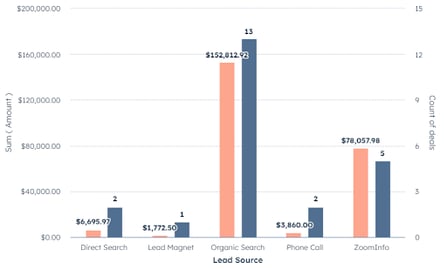From the emerging practice of “Revops” (revenue operations) to the increasing expansion of the CRO (chief revenue officer) role, marketing is being held more accountable to showing direct return on marketing investment (ROMI). And with most B2B marketing going digital, CMOs are expected to get granular and prove, with data, which initiatives resulted in positive returns and which didn't.
I love it. I’m a results-oriented kind of person — our strategic marketing workshop results in leading KPIs so that marketing is held accountable within strategic focus areas. At the end of each quarter, ROMI is expected to not only cover the full year of marketing expenses but also show a positive return.
At 1 Bold Step, we drive for at least 2x return in year one of an engagement, and at least 4-6x in the following years. This model works really well for most CEOs too. It’s math, after all, and it gives us a sense of certainty and control.
But is ROMI the most important KPI? Sometimes it is. But I’m beginning to see a trend that has me accepting that sometimes it isn’t.
When is ROMI the most important KPI?
Most of our clients want to grow quickly. They come to us because what they’ve done to get them to where they are today, isn’t helping them get to that next level — which makes sense. We all know what happens when you keep doing the same things over again, but expect different results.
Our clients typically have made “scaled and aggressive growth” one of their top priorities for the next few years. In this case, demand generation is a top priority and ROMI is the most important KPI.
They should put most of their marketing budget into direct advertising, events, trade shows, and outbound/cold email prospecting, all while establishing a strong, automated marketing and sales process that maximizes the generation of leads.
Money can fly out the door pretty quickly, which is why tracking campaign results is so important.
For example, what if you spent $5,000 on Google ads and generated $3,500 in new sales? As the saying goes; you’re not going to make it up in volume!
If you have a “net new” revenue goal and are looking for brand new relationships that result in sales, then ROMI is your primary KPI.
When does marketing influence become more interesting than ROMI?
Another great KPI is marketing influence, especially when your strategic marketing plan or overall business plan includes maximizing sales to current and/or past customers. You want marketing to dive in and segment your database, making it easier to cross-sell, upsell, and re-engage attrited customers.
Here’s where the ROMI calculation typically falls apart when you’re speaking to any known contact already in your database:
By definition, they are not “net new.” If you’re using any CRM built after 1995, there’s a field called “lead source,” and most records have an entry in that field.
Marketers have two primary ways they assign closed won sales to a lead source:
1. Original Lead Source
This is pretty self-explanatory. Some CRMs (like HubSpot) will automatically assign a lead source based on the way a contact came to your site or blog.
Examples include organic search, paid search, direct search, etc. Most marketing teams have added others like website/contact forms, specific landing pages, Google ads vs. LinkedIn ads, etc.
The report is pretty easy to create. You combine closed won deals with the primary contacts' first lead source. Then you identify which lead sources are “owned” by marketing — voila! ROMI versus sales by lead source.
This can be a simple and logical way to assign credit and value. But it does have its flaws:
- If you have a really long sales cycle, it takes a long time to see if something is working or not.
- You may have gotten the prospect at a show, but they purchased something 3 years later after 20 other touch points (and of those touches, which one should get the credit?).
2. “Last Touch”
Some marketing teams have taken a different approach and tracked the last marketing activity and apply credit for the sale that way. -2.png?width=344&height=258&name=unnamed%20(1)-2.png)
Here’s the problem with this approach. Your marketing team should be reaching out to people with different types of content based on where they are in the sales funnel to the right.
If they are, then only the bottom of the funnel activities are going to get credit for revenue. CEOs might misread/misunderstand this and be less likely to budget for top of the funnel and middle of the funnel activities — which are just as important as the entry for the leads that convert.
Marketing influence becomes more important than ROMI when you’re talking to many known contacts (already in your database).
In this case, we group marketing activities into campaigns so that we can track everything from a social post, to a blog, to a website visit, to an outbound campaign.
A marketing influence report shows you how many contacts are associated with closed-one deals and who also interacted with marketing materials. Or in other words, how many deals marketing ended up influencing.
This is a softer metric and not included in straight-line ROI calculations. Not clear? Here’s a great example:
- The marketing team creates custom thought leadership content twice a month and posts it to a company blog.
- Once a month, the blogs are highlighted in the customer newsletter.
- A customer opens the newsletter, clicks through to the blog, and reads the content.
- The customer talks to their sales rep and orders something new.
- The amount of that sale is connected to the customer who is connected with the blog.
- An influence report shows the total dollars that have been influenced by the blog.
Regardless of if the original lead source was owned by marketing, or if the customer was the owner’s Great Aunt, marketing’s efforts influenced this deal. Some credit should be given to marketing. But it’s impossible to say just how much.
Marketing that isn’t Targeted to Customers at All
I used to say, “If marketing isn’t driving sales, then it’s not working.”
Hello 2020 and the great talent crunch.
As part of our strategic marketing plan workshop, we work to align marketing efforts with overall business focus areas. If you’re like many of our clients, employee recruitment and retainment are strategic goals, and marketing should help here! But don’t expect ROI in terms of revenue.
This is where marketing needs to clearly articulate your why and your values. They also need to clearly and strongly support any and all donations and volunteer work done by the company. This is not bragging! This is you clearly showing your values so that you will attract the people that care about the same things you do.
My co-worker, Tom Slager, recently wrote a blog about why selecting and supporting specific charities that matter to you and your team are a win-win-win. If you’d like to learn more about that, his insights come from years of working with the United Way and they make perfect sense given the changing values in the younger workforce.
It All Depends on Your Goals
Depending upon your overall goals, ROMI may or may not be your most important metric.
There are other things marketing does that also doesn’t have a direct path to revenue (like branding, positioning, swag, and more). How does one calculate the ROI of putting your logo on golf balls? You can’t. But CEOs ask for them every spring.
When I’m asked which tactic will show the best and fastest return, I always hesitate. With a modern marketing plan, it shouldn’t just be one thing. It should be a combination of the right things.
ROMI is your best KPI at budgeting time when you need to prove that your spend is value add (and not overhead), but if you want a consistent flow of leads and sales, don’t forget the softer side of marketing. For more great marketing advice, click here to subscribe to our blog.





